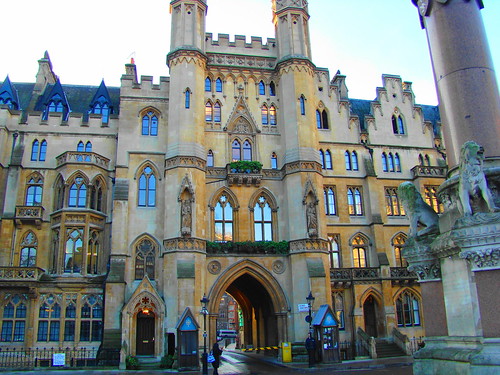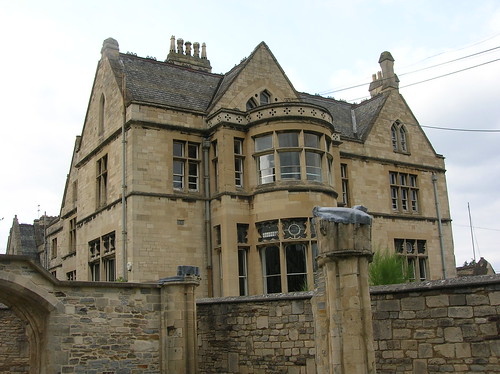Thomas Ravis was one of the six deans who attended the Hampton Court Conference in 1604. As a result, he was appointed director of the Second Oxford company involved in the creation of the King James Bible. This group translated the Gospels, the Acts and the book of Revelation. Sir Henry Savile and John Peryn were included in this group. Ravis later supplied notes for William Barlow's account, the Sum and Substance of the Conference.
Early days
Ravis was born in 1560 at Malden, in the county of Surrey, and died 1609. His education began at the famous Westminster School. Its list of old pupils display a galaxy of talent: Andrew Lloyd-Webber, Nick Clegg, John Locke, Charles Wesley, JN Darby, Sir Peter Ustinov, and winners of six VCs! – to name only a few. Later Ravis was to show great favour to students from his old school, encouraging and advising them in their studies (1)
Westminster SchoolIn 1575 Ravis became a student of Christ’s Church, one of the Oxford Colleges, and founded by Cardinal Wolsey. The dean and chapter of Christ Church were reluctant to make a place for him, until a strong letter from William Cecil (Lord Burghley) overcame it. Over the next twenty years he pursued courses in both Arts (MA 1581), and Divinity (DD 1595).
Says McClure, “It is enough to record, that [the King James translators] nearly all attained to the highest literary honours of their respective universities.”
An influential cleric
He ‘took holy orders’ in 1582, and preached around Oxford for some time. From 1591 he was vicar of Allhallows Barking, in London for seven years. Then followed an appointment as Canon of Westminster, and two years after that he was made Dean of Christ’s Church College, Oxford. In 1596 he was elected Vice-Chancellor of the University. In 1598, he exchanged his All- hallows Church for the rectory of Islip. He also held the Abbey Church, in Wittenham Berkshire. These appointments took him into the inner circle of influential churchmen, where he rose fast in its elite social network, and he exercised a strong personal resistance to the Puritan influence of John Rainolds and his group.
In October 1604 Ravis was appointed Bishop of Gloucester, whilst still remaining dean of Christ Church, and holding his Westminster prebend, as well as the parsonages of Islip and Wittenham.
His holding a plurality of churches for the sake of their revenues, in neither of which he could perform the duties of the pastoral office [justified complaint] . . . The pernicious custom of pluralities, whereby a man receives tithes for the care of souls of which he takes no care, fleecing the flock he neither watches nor feeds, is one of those abuses still continued in the Church of England . . . [but not practised now]” McClure
A persecutor of Puritans
Thomas Ravis’s persecuting spirit towards the Puritans makes it difficult for biographers to commend him as a translator. Increasing conflict within the higher offices of the clergy made it certain that the list of translators would be staunch representatives of the then established order, where the authority of the bishop was ever more appealed to, in order to resolve the pain caused by conflicting viewpoints. Lancelot Andrewes appealed to episcopal authority at the Hampton Court conference with the words:
The occasion which caused the apostles to appoint bishops seemeth to be schisms . . . . The whole ministry of the New Testament was at the first invested in Christ alone. He is termed . . . bishop, 1 Peter 2: 25.”No appeal was made to the Bible to justify the diocesan tradition where many congregations are ruled by one bishop. Edwin Hatch’s lectures tended to show that the earliest Biblical order was quite different,
For although it is indisputable that our Lord founded a church, it is an unproved assumption that the church is an aggregation of visible and organised societies. . . . The theory upon which the public worship of the primitive churches proceeded was that each community was complete in itself, and that in every act of public worship every element of the community was present.”(2)
Part of the New Testament evidence for the congregational view (assuming the authority of biblical precedent) is seen in Acts 20. There we read Paul gathered together at Miletus the elders (presbuteroi) of Ephesus. These same men are at the same time denoted “overseers” (episopoi: bishops) by the writer Luke, in Acts 20:17, 28. This shows that in the earliest times, instead of one bishop ruling many churches, it was the reverse, wherein several bishops (episcopoi: overseers) ruled one church, that is, one local congregation.
Paine says Ravis was “haughty and harsh” speaking against the Puritans at some length at the Hampton Court Conference. (1)Ravis’ appointment as Bishop of London brought on a strong persecuting spirit in line with his predecessor, Richard Bancroft. He showed a severe exacting intolerance of all nonconformity. His determination to bring uniformity of outlook to his diocese made him blind to the virtues of those he opposed. For example, he interviewed, says McClure:
the holy and blessed man, Richard Rogers, [who was] for nearly fifty years the faithful minister of Weathersfield, than whom, it is said, “the Lord honoured none more in the conversion of souls.” In the presence of this venerable man, who, for his close walking with God, was styled the Enoch of his day, Bishop Ravis protested,--”By the help of Jesus, I will not leave one preacher in my diocese, who doth not subscribe and conform.”The writer reposts:
The poor prelate was doomed to be disappointed; as he died, before his task was well begun . . . . So true is the remark, that “bishops and books are seldom the better for being translated.”
The term “bishop” was finally prominent in translating the pastoral epistles of Paul, being conspicuously used five times, where “overseer” would have allowed for the Puritan conviction that pastoral care is best exercised by someone present and directly involved in ruling a local congregation. It is hardly surprising that a company of translators, which included many bishops among them, would result in the final translation-product reflecting what was then the established order. The overall director, Lancelot Andrewes, with his high church leanings, had the final word, and he ensured it would be so!
A man of social affairs
In 1604, soon after Dr. Ravis was commissioned as a translator, he also became bishop of Gloucester. There
he spent lavishly on social affairs, and it was said that he ‘in so short a time had gained the good liking of all sorts that some who could not brook the name of bishop were content to give (or rather to pay) him a good report. He also constructed conduits to bring water into his bishop’s palace, built much of it anew, and improved the paving.(1)
His appointment was ostensibly for “his great learning, gravity, and prudence” and he seems to have been well accepted: “[Though] his diocese “was pretty well stocked with those who could not bear the name of a bishop, yet, by his episcopal living among them, he obtained their love, and a good report from them.” Paine calls him “stringent but sociable.” (1)
“Known as a ‘grave and good man,’ Ravis was able at getting work done and considered a model for lesser folk to revere, but clearly not a man without choler. In retrospect we may think him an odd choice for chairman of the group to work on the writing that contains the heart of Christian teaching.” (1)
His competence as a translator
Thomas Ravis would have learned Greek, Latin, Hebrew and Arabic as part of the curriculum of the upper school at Westminster in early days. Whether he excelled in these disciplines we are not told. There is no record of a particular aptitude for languages. Neither do we hear whether he immersed himself in the writings of the early Christian ‘fathers,’ whose work is so important in offering a critique of modern text-critical methods. Doubtless he would have kept in touch with classical languages during the twenty years which led up to his receiving a doctorate. However, his specialty seems to have been more to do with practical ecclesiastical affairs, and a doctrinal preoccupation with defeating the Puritan influence in church life.
“While he worked on the Bible, he was highly active as a hated scourge.” (1)
Notwithstanding, McClure gives Ravis the benefit of the doubt, saying:
Though too much carried away by a zeal for the forms of his Church, which was neither according to knowledge nor charity, he lived and died in deserved respect, and hath a fair monument still standing in his cathedral of St. Paul’s.
Ravis died on 14 December 1609, and was buried in the north aisle of St. Paul's Cathedral.
(1) Paine, Gustavus S. (1977/1959) The men behind the King James Version, MI: Baker, pp. 50-51, 93, 98, 104.
(2) Lang, G.H. (1959) The Churches of God Lon: Paternoster. P.15
(3) Wilson, Derek (2010) The People’s Bible: The remarkable history of the King James Version, OX: Lion, p. 100
This is 13/52. Previous Next Index

